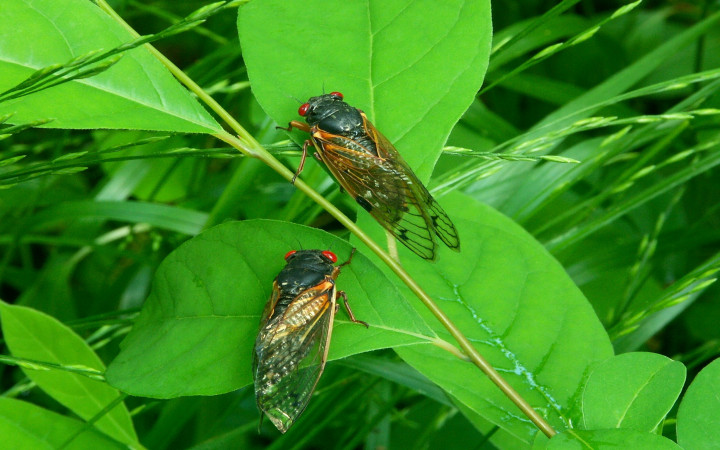Today’s Wonder of the Day was inspired by Jill from Cincinnati. Jill Wonders, “Why do Cicadas come out every 17 years?” Thanks for WONDERing with us, Jill!
Hello, and welcome back to Wondero—wait, hold on a minute. Do you hear that? If not, maybe you see them. You might even be able to feel the vibration from all the noise they’re making. What are we talking about? The ruckus caused by this giant swarm of cicadas, of course!
If you live in or near a cicada habitat, you know what we mean. These small insects can be quite loud. Males of the species make most of the noise. They vibrate membranes on their abdomens to buzz, producing a mating call like none other.
In fact, swarms of buzzing cicadas have been known to reach 100 decibels. Are you WONDERing just how loud that is? Imagine standing just a few feet away from a revving motorcycle. Yes, they are that loud! It’s also similar to being near a chainsaw or next to a speaker at a concert.
Of course, their noise isn’t the only thing that makes cicadas unique. If you live in North America, you may already know the buzz of the cicadas as a rare occurrence. In fact, in many places, it only happens once every 17 years!
Why is that? North America is home to 15 broods of periodical cicadas. Of the over 3,000 species of this insect, those on this continent are the only ones considered periodical. Like all cicadas, they live most of their lives underground. However, 12 of these broods only emerge every 17 years. The other three broods emerge every 13 years.
Elsewhere on the planet, cicadas emerge each year. These are called annual cicadas, and they live much shorter lives than periodical species—between two and five years. They still only emerge once in their lives—in order to mate. However, their life cycles overlap so that a brood of the insects come above ground each year.
Why do some broods only emerge every 17 years? It has to do with the cicada life cycle. First, female cicadas lay eggs—up to 400 of them. Once these eggs hatch, nymph cicadas emerge and burrow into the ground. There, they feed on liquid from plant roots. They spend between four and 17 years in this phase of life.
Finally, the nymph cicada emerges to become an adult. While above ground, they feed on sap from twigs and other vegetation. They also molt, meaning they shed their nymph exoskeleton. You may have seen the results of this process before. Adult cicadas leave behind an empty shell of their previous form.
Scientists aren’t certain what causes a brood to emerge every 13 or 17 years. However, they believe the cycle has evolved to help cicadas avoid predators. The insects are food for many animals, including birds, lizards, and sometimes humans. By emerging at strategic times, cicadas may avoid some dangers and have a more successful mating season.
Have you ever heard the buzz of a cicada brood? Maybe you’ve seen the exoskeletons left behind by their molt. One thing is certain—cicadas are some of the most unique creatures on planet Earth!
Standards: NGSS.LS1.A, NGSS.LS1.B, NGSS.LS1.C, CCRA.R.1, CCRA.R.2, CCRA.R.4, CCRA.R.10 CCRA.L.3, CCRA.L.6, CCRA.W.2, CCRA.W.4, CCRA.W.7, CCRA.W.8, CCRA.W.9, CCRA.W.10, CCRA.SL.1, CCRA.SL.2




